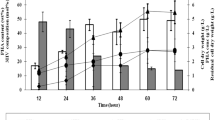Abstract
Cupriavidus sp. USMAA1020, a local isolate was able to biosynthesis poly(3-hydroxybutyrate-co-4-hydroxybutyrate) [P(3HB-co-4HB)] copolymer with various 4HB precursors as the sole carbon source. Manipulation of the culture conditions such as cell concentration, phosphate ratio and culture aeration significantly affected the synthesis of P(3HB-co-4HB) copolymer and 4HB composition. P(3HB-co-4HB) copolymer with 4HB compositions ranging from 23 to 75 mol% 4HB with various mechanical and thermal properties were successfully produced by varying the medium aeration. The physical and mechanical properties of P(3HB-co-4HB) copolymers were characterized by NMR spectroscopy, gel-permeation chromatography, tensile test, and differential scanning calorimetry. The number-average molecular weights (M n) of copolymers ranged from 260 × 103 to 590 × 103Da, and the polydispersities (M w/M n) were between 1.8 and 3.0. Increases in the 4HB composition lowered the molecular weight of these copolymers. In addition, the increase in 4HB composition affected the randomness of copolymer, melting temperature (T m), glass transition temperature (T g), tensile strength, and elongation to break. Enzymatic degradation of P(3HB-co-4HB) films with an extracellular depolymerase from Ochrobactrum sp. DP5 showed that the degradation rate increased proportionally with time as the 4HB fraction increased from 17 to 50 mol% but were much lower with higher 4HB fraction. Degradation of P(3HB-co-4HB) films with lipase from Chromobacterium viscosum exhibited highest degradation rate at 75 mol% 4HB. The biocompatibility of P(3HB-co-4HB) copolymers were evaluated and these copolymers have been shown to support the growth and proliferation of fibroblast cells.







Similar content being viewed by others
References
Ojumu TV, Yu J, Solomon BO (2004) Production of polyhydroxyalkanoates, biodegradable polymer. Afr J Biotechnol 3(1):18–24
Sudesh K, Doi Y (2000) Molecular design and biosynthesis of biodegradable polyesters. Polym Adv Technol 11:865–872. doi:10.1002/1099-1581(200008/12)11:8/12<865::AID-PAT34>3.0.CO;2-Z
Khanna S, Srivastava AK (2005) Recent advances in microbial polyhydroxyalkanoates. Process Biochem 40(2):607–619. doi:10.1016/j.procbio.2004.01.053
Doi Y (1990) Microbial polyesters. Wiley-VCH, New York
Anderson AJ, Dawes EA (1990) Occurrence, metabolism, metabolic role and industrial uses of bacterial polyhydroxyalkanoates. Microbiol Rev 54(4):450–472
Sudesh K, Abe H, Doi Y (2000) Synthesis, structure and properties of polyhydroxyalkanoates: biological polyesters. Prog Polym Sci 25:1503–1555. doi:10.1016/S0079-6700(00)00035-6
Reddy CS, Ghai R, Rashmi Kalia VC (2003) Polyhydroxyalkanoates: an overview. Bioresour Technol 87(2):137–146. doi:10.1016/S0960-8524(02)00212-2
Bhatt R, Shah D, Patel KC, Trivedi U (2008) PHA-rubber blends: synthesis, characterization and biodegradation. Bioresour Technol 99:4615–4620. doi:10.1016/j.biortech.2007.06.054
Wang YJ, Hua FL, Tsang YF, Chan SY, Sin SN, Chua H, Yu PHF, Ren NQ (2007) Synthesis of PHAs from waste under various C:N ratios. Bioresour Technol 98:1690–1693. doi:10.1016/j.biortech.2006.05.039
Chanprateep S, Katakura Y, Visetkoop S, Shimizu H, Kulpreecha S, Shioya S (2008) Characterization of new isolated Ralstonia eutropha strain A-04 and kinetic study of biodegradable copolyester poly(3-hydroxybutyrate-co-4-hydroxybutyrate) production. J Ind Microbiol Biotechnol (in press)
Martin DP, Williams SF (2003) Medical applications of poly-4-hydroxybutyrate: a strong flexible absorbable biomaterial. Biochem Eng J 16:97–105. doi:10.1016/S1369-703X(03)00040-8
Zinn M, Witholt B, Egli T (2001) Occurrence, synthesis and medical application of bacterial polyhydroxyalkanoate. Adv Drug Deliv Rev 53:5–21. doi:10.1016/S0169-409X(01)00218-6
Saito Y, Nakamura S, Hiramitsu M, Doi Y (1996) Microbial synthesis and properties of poly(3-hydroxybutyrate-co-4-hydroxybutyrate). Polym Int 39(3):169–174. doi:10.1002/(SICI)1097-0126(199603)39:3<169::AID-PI453>3.0.CO;2-Z
Chee JW, Amirul AA, Tengku Muhammad TS, Majid MIA, Mansor SM (2008) The influence of copolymer ratio and drug loading on the biocompatibility of P(3HB-co-4HB) synthesized by Cupriavidus sp. (USMAA2–4). Biochem Eng J 38(3):314–318. doi:10.1016/j.bej.2007.07.018
Yang XS, Zhao K, Chen GQ (2002) Effect of surface treatment on the biocompatibility of microbial polyhydroxyalkanoates. Biomaterials 23:1391–1397. doi:10.1016/S0142-9612(01)00260-5
Amirul AA, Yahya ARM, Sudesh K, Azizan MNM, Majid MIA (2008) Biosynthesis of poly(3-hydroxybutyrate-co-4-hydroxybutyrate) copolymer by Cupriavidus sp. USMAA1020 isolated from Lake Kulim, Malaysia. Bioresour Technol 99:4903–4909. doi:10.1016/j.biortech.2007.09.040
Amirul AA, Tay BY, Chang CW, Azizan MNM, Majid MIA, Sudesh K (2004) Biosynthesis and characterization of poly(3-hydroxybutyrate-co-4-hydroxybutyrate) produced by Ralstonia sp. isolated from soil. J Biosci 15(2):125–135
Braunegg G, Sonnleitner B, Lafferty RM (1978) A rapid gas chromatographic method for the determination of poly-β-hydroxybutyric acid in bacterial biomass. Eur J Appl Microbiol Biotechnol 6:29–37. doi:10.1007/BF00500854
Steinbuchel A, Lütke-Eversloh T (2003) Metabolic engineering and pathway construction for biotechnological production of relevant polyhydroxyalkanoates in microorganisms. Biochem Eng J 16:81–96. doi:10.1016/S1369-703X(03)00036-6
Kunioka M, Nakamura Y, Doi Y (1988) New bacterial copolyester produced from Alcaligenes eutrophus from organic acids. Polym Commun (Guildf) 29:174–176
Shuler LM, Kargi F (1992) Bioprocess engineering, basic concepts. Prentice Hall, Upper Saddle River
Hein S, Sohling B, Gottschalk G, Steinbuchel A (1997) Biosynthesis of poly(4-hydroxybutyric acid) by recombinant strains of Escherichia coli. FEMS Microbiol Lett 153:411–418
Lee WH, Azizan MNM, Sudesh K (2004) Effects of culture conditions on the composition of poly(3-hydroxybutyrate-co-4-hydroxybutyrate) synthesized by Comamonas acidovorans. Polym Degrad Stab 84:129–134. doi:10.1016/j.polymdegradstab.2003.10.003
Mitomo H, Hsieh WC, Nishiwaki K, Kasuya K, Doi Y (2001) Poly(3-hydroxybutyrate-co-4-hydroxybutyrate) produced by Comamonas acidovorans. Polymer (Guildf) 42(8):3455–3461. doi:10.1016/S0032-3861(00)00678-9
Nakamura S, Doi Y (1992) Microbial synthesis and characterization of poly(3-hydroxybutyrate-co-4-hydroxybutyrate). Macromolecules 25(17):4237–4241. doi:10.1021/ma00043a001
Saito Y, Doi Y (1994) Microbial synthesis and properties of poly(3-hydroxybutyrate-co-4-hydroxybutyrate) in Comamonas acidovorans. Int J Biol Macromol 16:99–104. doi:10.1016/0141-8130(94)90022-1
Kumagai Y, Kanesawa Y, Doi Y (1992) Enzymatic degradation of microbial poly(3-hydroxybutyrate) films. Macromol Chem 193:53–57. doi:10.1002/macp.1992.021930105
Acknowledgment
The authors acknowledge the research grant provided by MOSTI, Malaysia (Science Fund, 02-01-05-SF0064) that has resulted in this article.
Author information
Authors and Affiliations
Corresponding author
Rights and permissions
About this article
Cite this article
Vigneswari, S., Vijaya, S., Majid, M.I.A. et al. Enhanced production of poly(3-hydroxybutyrate-co-4-hydroxybutyrate) copolymer with manipulated variables and its properties. J Ind Microbiol Biotechnol 36, 547–556 (2009). https://doi.org/10.1007/s10295-009-0525-z
Received:
Accepted:
Published:
Issue Date:
DOI: https://doi.org/10.1007/s10295-009-0525-z




